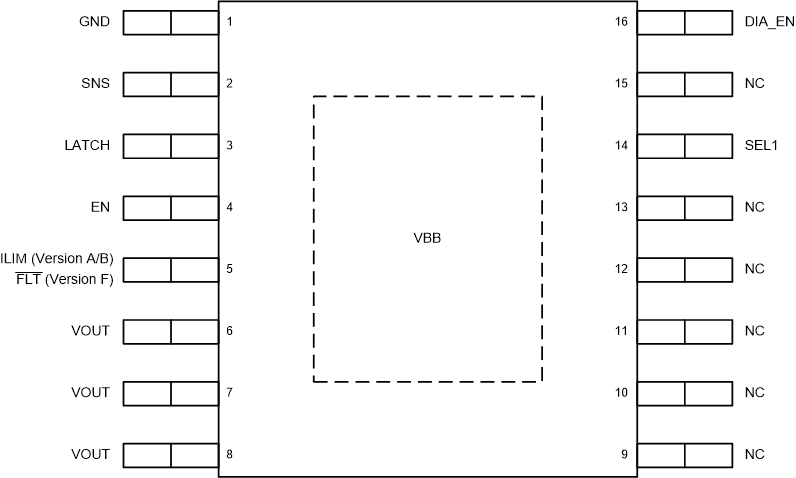ZHCSJT6B may 2019 – february 2023 TPS1HB16-Q1
PRODUCTION DATA
- 1 特性
- 2 应用
- 3 说明
- 4 Revision History
- 5 Device Comparison Table
- 6 Pin Configuration and Functions
- 7 Specifications
- 8 Parameter Measurement Information
-
9 Detailed Description
- 9.1 Overview
- 9.2 Functional Block Diagram
- 9.3
Feature Description
- 9.3.1 Protection Mechanisms
- 9.3.2 Diagnostic Mechanisms
- 9.4 Device Functional Modes
- 10Application and Implementation
- 11Device and Documentation Support
- 12Mechanical, Packaging, and Orderable Information
6 Pin Configuration and Functions
 Figure 6-1 PWP Package16-Pin HTSSOPTop View
Figure 6-1 PWP Package16-Pin HTSSOPTop ViewTable 6-1 Pin Functions
| PIN | I/O | DESCRIPTION | ||
|---|---|---|---|---|
| NAME | VERSION A/B | VERSION F | ||
| GND | 1 | 1 | — | Device ground |
| SNS | 2 | 2 | O | Sense output |
| LATCH | 3 | 3 | I | Sets fault handling behavior (latched or auto-retry) |
| EN | 4 | 4 | I | Control input, active high |
| ILIM | 5 | - | O | Connect resistor to set current-limit threshold |
| FLT | - | 5 | O | Open drain output with pulldown to signal fault. |
| VOUT | 6 - 8 | 6 - 8 | O | Channel output |
| NC | 9 - 13, 15 | 9 - 13, 15 | I | No Connect, leave floating |
| SEL1 | 14 | 14 | I | Diagnostics select. No functionality on device version F; connect to IC GND through RPROT resistor |
| DIA_EN | 16 | 16 | I | Diagnostic enable, active high |
| VBB | Exposed pad | Exposed pad | I | Power supply input |